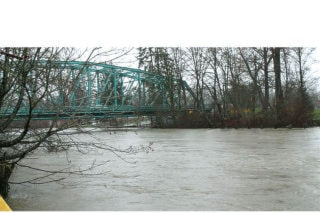Despite heavy rainfall and a flood alert notice issued Christmas Eve, widespread flooding did not occur in Courtenay over the weekend.
BC Hydro said the stormy weather had little impact on the Comox Lake Reservoir as water inflows were lower than anticipated.
The weather, however, had a huge impact on low-elevation rivers such as the Tsolum.
By Friday afternoon, it had set a peak flow record of 278 cubic metres per second, breaking the previous high of 275 in November, 2009.
BC Hydro spokesperson Stephen Watson said it has been a “remarkable weather year,” especially during the three-week period when the Tsolum recorded its highest and third highest peak river flows in more than 50 years.
“Things are pretty good,” Watson said Monday. “We’ve been seeing high volumes of water over the last number of days and holding the reservoir.”
During a 36-hour period late last week, Eric Creek received 190 millimeters of precipitation — mostly snow — while Cruikshank River was hit by 210 mm and Comox Dam 120 mm. Fortunately, snow melt levels have been lower than forecast, Watson said.
After maintaining a low discharge rate throughout the day, BC Hydro increased discharge from the dam about five-fold.
As of Saturday, the reservoir was sitting at 134.4 metres, or about 90 cm from free-spilling over the dam.
Gauge 10 at the Fifth Street Bridge hit a high of 4.43 metres Friday morning, caused by the king tide, storm surge and high natural river flows. During the January floods, the gauge hit a maximum of 4.5 metres.
Last week, the city had issued a flood alert notice at Puntledge and Tsolum roads, Maple Pool Campsite, Anderton Avenue and the Condensory Bridge. Sandbags had been placed around facilities such as the Linc Youth Centre, which was damaged during floods last November and January.
Courtenay’s Emergency Operations Centre was on standby in case it needed to be activated.
With the weather event over, BC Hydro was able to target ideal kayak flows on Monday and Tuesday.
reporter@comoxvalleyrecord.com



